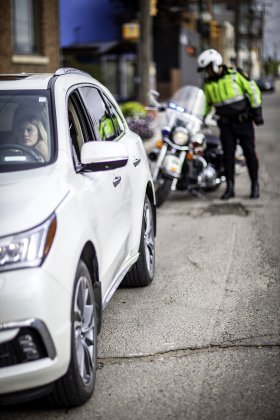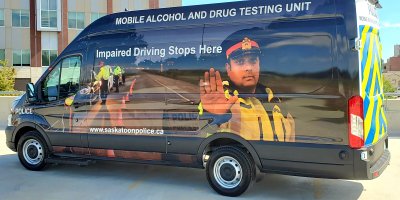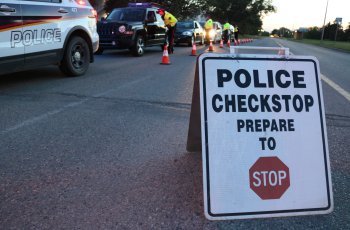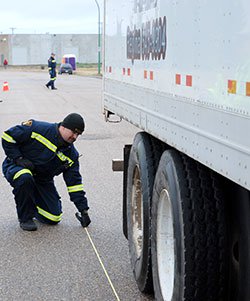Traffic Unit

The Saskatoon Police Service Traffic Unit is committed to ensuring the safety of all Saskatoon residents and visitors to our city who share our roads, sidewalks, and bike trails. In addition to enforcement activity, the Traffic Unit also encompasses collision and hit and run investigations.
Our enforcement team uses selective techniques, as well as targeted traffic projects, and a variety of educational campaigns in order to maximize compliance with provincial and municipal driving legislation. Police officers are highly trained in the use of Radar and Laser speed detection technology, and are equipped with the latest tools of the trade to effectively perform their duties. They use a variety of vehicles, including motorcycles to patrol our streets.
Saskatoon Police Traffic officers regularly team up with outside agencies such as the Saskatchewan Highway Transport Patrol, Vehicle Equipment Compliance inspectors, University of Saskatchewan Campus Patrol, RCMP and other municipal police services for the purpose of safety campaigns. Operation Street Sweep, Multi Agency Seat belt Team (MAST), Operation Overdrive Sobriety Checkpoints and child seat safety clinics are but a few examples of this collaborative effort geared towards the creation of a safe roadway network.
For any questions or concerns related to traffic safety, please feel free to contact the Saskatoon Police Traffic Unit by email at trafficunit@police.saskatoon.sk.ca.
Combined Traffic Services Saskatchewan
Combined Traffic Services Saskatchewan includes two integrated units, a partnership between the Saskatoon Police Service Traffic Unit, the RCMP and SGI. The creation of these units came as a recommendation from the Saskatchewan Legislature all-party traffic safety report and when the laws for distracted, impaired and excessive speeding changed to include harsher penalties. Each unit consists of 30 officers, 15 from existing provincially funded positions and 15 new officers funded by SGI. Of these, 50 officers (25 per unit) are RCMP officers and 10 (5 per unit) are SPS members. These two units enforce traffic laws on highways in central and southeastern Saskatchewan.
Sobriety Checkpoint Program

The Saskatoon Police Service is committed to eliminating deaths and injuries caused by impaired driving by participating in the High Visibility Enforcement (HVE) program funded by SGI.
HVE consists of Sobriety Checkpoints being set up in cities and rural areas across Saskatchewan to screen drivers for impairment. In Saskatoon, approximately 30 of these HVE checkpoints take place throughout the year, resulting in thousands of drivers being screened annually.
In 2020, the Saskatoon Police Service partnered with the provincial government to acquire The Mobile Alcohol and Drug Testing Unit. The van is equipped with a fully functional Breathalyzer and Drug tester. In most cases, impaired drivers will be processed and released from the scene of the sobriety checkpoint, without the need for being arrested and transported to Detention.
How do sobriety checkpoints work?
Police officers funnel traffic into a single lane and direct cars into a designated lane to speak with an officer. Some traffic may be directed to bypass the checkpoint lane when it is at capacity.
A police officer will approach the car and ask the driver about alcohol and drug consumption. If no concerns are raised, the driver will be released immediately. If concerns are raised, the driver will be directed into a secondary screening area for further investigation which may include the use of a drug or alcohol screening device or Standardized Field Sobriety Tests.
What is Mandatory Alcohol Screening?

According to the World Health Organization, 121 countries in the world have Mandatory Alcohol Screening laws in place. Studies have shown that Mandatory Testing laws can reduce impaired driving fatalities by as much as 35%. The process of screening a sober individual takes approximately 90 seconds.
Silhouettes for Safety

Silhouettes for Safety is a program initiated by the Saskatoon Police Service and sponsored by SGI to remind drivers to slow down in school zones. It features metal speed zone signs placed strategically in school zones, right in the center lane of traffic where drivers can't miss them.
The school zone signs were constructed by Saskatchewan Association of Rehabilitation Centres (SARC), Saskatchewan Abilities Council and The City of Saskatoon sign shop. The signs are placed at each end of the school zone by a school official at the beginning of the school day and removed again at the end of the day.
This project addresses the issue of speed management, where Saskatoon drivers fail to identify school zones and adjust their speed accordingly. These drivers are not only committing a speed violation, they are also decreasing the safety of the students, parents, teachers and citizens that are using these school zones. In other cities, these strategically placed school zone signs have been completely effective.
Collision Investigation
The Traffic Unit is also responsible for the investigation of serious motor vehicle collisions and hit and run collisions. To this end, the unit uses a team of investigators specializing in both fields.
Hit and Run investigators are experts at matching up damage between vehicles. They work closely with the auto insurance industry to bring hit and run violators to justice.
The Collision Analyst Unit is made up of a group of highly trained officers who are responsible for investigating serious injury and fatal collisions. These officers receive ongoing first rate training in various disciplines including physics, math, photography, forensic mapping and 3-D animation. In addition to this training, some members of the team have received specialized training in the investigation of collisions involving motorcycles, pedestrians and commercial vehicles.
Commercial Vehicle Enforcement

Traffic safety concerns are a high priority for the Saskatoon Police Service, through an ongoing team approach, we are constantly striving to improve the quality of life and safety of all our citizens.
Excessive Noise from Vehicles
Saskatoon, like other cities throughout the country, has received repeated complaints about excessive vehicle noise.
The Traffic Safety Act prohibits vehicles from creating “loud and unnecessary noise” while the Vehicle Equipment Regulations require mufflers that “effectively reduce noise.” Both provide penalties for violations.
The City of Saskatoon has gone further to protect its citizens from harsh and abrasive noises through amendments to Saskatoon Bylaw 8244 - The Noise Bylaw.
The bylaw specifically addresses the manner in which some drivers choose to operate and equip their vehicles that result in unnecessary noise.
Specifically, Section 5.1(a) addresses manner of operation. An example of this would be repeatedly increasing engine speed while stopped at a red light. Such actions would be considered unnecessary. Convictions have already been made under this section.
Section 5.1(c) addresses motorcycle exhaust noise. Motorcycles off the assembly line already meet the industry standard for acceptable noise levels. Problems occur when owners modify their motorcycles with loud exhaust systems. Citizens complain about the excessive noise. The maximum allowable decibel levels are 92 dB(A) at idle speed and 96dB(A) above idle speed.
Section 5.4 sets out as an offence a refusal to allow the police to test your motorcycle for sound.
Motorcycle noise testing, education and enforcement are part of the SPS response to citizen concerns regarding excessive noise and its impact on quality of life. The Saskatoon Police Traffic Unit has purchased five sirometers, two sound meters and one anemometer.
Vehicle Standards
Information related to vehicle standards, windshield damage, vehicle modifications and motorcycle equipment standards can be found at the Saskatchewan Government Insurance website.
Red Light Cameras
Information about red light cameras can be found at the City of Saskatoon website.
Photo Speed Enforcement
For information on Photo Speed Enforcement, please visit the City of Saskatoon website and the Saskatchewan Government Insurance website
